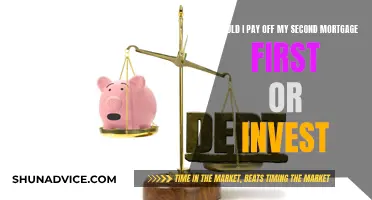
Flipping and buy-and-hold investing are two distinct real estate investment strategies, each with its own set of pros and cons. Flipping involves purchasing a property, making renovations, and selling it for a profit within a short timeframe, while buy-and-hold investors rent out properties for long-term income. Flipping can be lucrative and exciting, but it's also risky and requires careful financial management and knowledge of the real estate market. On the other hand, buy-and-hold investing offers more stable, passive income but demands the responsibilities of a landlord, including finding and managing tenants. Ultimately, the choice between these strategies depends on individual goals, risk tolerance, and the amount of time one can devote to their investments.
| Characteristics | Values |
|---|---|
| Timeframe | Flipping: Short-term; quick turnaround and pace |
| Buy-and-hold: Long-term; stable | |
| Income type | Flipping: Active income |
| Buy-and-hold: Passive income | |
| Profit | Flipping: Potential for fast profit; profitable |
| Buy-and-hold: Less profit initially | |
| Risk | Flipping: Risky; potential money loss |
| Buy-and-hold: Safer; less stressful | |
| Work involved | Flipping: Requires knowledge, planning, and savvy |
| Buy-and-hold: Requires skill to be a property manager | |
| Taxes | Flipping: Profits taxed as normal income (22-37%) if sold within a year, or as capital gains (15-20%) if sold after a year |
| Buy-and-hold: Tax deductions for associated expenses, mortgage interest, insurance premiums, property taxes, legal fees, depreciation, and property management fees; taxed at lower capital gains rate | |
| Market conditions | Flipping: Depends on market conditions; hot markets can cool unexpectedly |
| Buy-and-hold: Less dependent on market timing |
What You'll Learn
- Flipping houses is risky as there is no guarantee of a price increase in a short time frame
- Flipping can be a gamble and lead to potential money loss
- Buy-and-hold investing is a stable, less stressful form of investment
- Buy-and-hold investing provides passive income and tax advantages
- Flipping requires a lot of time and can be expensive

Flipping houses is risky as there is no guarantee of a price increase in a short time frame
Flipping houses is a risky business venture due to the inherent unpredictability of the real estate market. One of the primary risks is the absence of any guarantee that the property's value will increase within a short timeframe. This uncertainty can lead to financial losses if the market undergoes a correction or enters a recessionary phase.
The risk of losing money is a significant concern in house flipping. Several factors can contribute to this, such as overpaying for a property, overestimating its resale value, underestimating repair costs, underestimating the time needed to complete the project, and hiring incompetent contractors. These mistakes can result in substantial financial losses, causing emotional and financial stress for investors.
Another challenge is the potential for unanticipated expenses, including building permits, contractor delays, and unforeseen renovations or materials. These additional costs can quickly accumulate and erode any potential profits. Furthermore, tax increases and capital gains taxes can further diminish returns.
The longer an investor holds onto a property, the more money they lose due to ongoing expenses such as mortgage, taxes, insurance, and maintenance. If the property remains on the market for an extended period, it may become necessary to reduce the asking price, further eating into any anticipated profits.
Flipping houses is also a time-consuming endeavour. It requires a significant time investment to find the right property, undertake renovations, and navigate the selling process. This can be particularly challenging for individuals with day jobs, as they will need to balance their time between their career and the flipping project.
The Debt Dilemma: Navigating the Path to Financial Freedom
You may want to see also

Flipping can be a gamble and lead to potential money loss
Flipping can be a risky business, and there are several factors that can lead to potential money loss. Firstly, it is important to remember that flipping is a short-term strategy, and there is no guarantee that the value of the asset will increase during the holding period. If market conditions change unexpectedly, investors may be left holding a depreciating asset. This is especially true for those who flip in a hot market, as these are more likely to cool down suddenly.
Secondly, flipping requires a significant amount of knowledge, planning, and expertise. Common mistakes made by novice flippers include underestimating the time and money required, as well as overestimating their skills and knowledge. It is crucial to have a clear understanding of the costs, the process, and the best renovations to get a good return on investment. Patience and good judgment are also essential in this timing-based business.
Thirdly, flipping can be time-consuming and may require giving up personal time or paying others to do the work, reducing overall profits. Finding the right property can take months, and once it is acquired, there are costs associated with renovation, maintenance, and holding the property until it is sold. These costs can include loan payments, property taxes, insurance, utilities, and more.
Lastly, there are financial risks involved in flipping. Interest on borrowed money used to finance the acquisition is only partially tax-deductible, and other costs such as renovation and holding costs can cut into profits. There is also the possibility of unexpected structural problems, which can turn a gross profit into a net loss. Therefore, it is important for investors to carefully consider their financial abilities and the potential risks before deciding to flip a property.
Smart Ways to Invest $2000
You may want to see also

Buy-and-hold investing is a stable, less stressful form of investment
The buy-and-hold strategy is particularly effective for investors seeking healthy long-term returns. It is often recommended by investment experts such as Warren Buffett, Jack Bogle, and Burton Malkiel. These advocates argue that, in the long run, there is a strong correlation between the stock market and economic growth. By holding onto investments over time, investors can benefit from compound interest, which gradually builds wealth.
This strategy is also less susceptible to the risks of market timing. Trying to time the market requires investors to be successful twice: once when buying and again when selling. This is challenging, as the market's pattern of returns is unpredictable from month to month. In contrast, a buy-and-hold approach ensures a consistent long-term investment, reducing the chances of missing out on the market's biggest gains.
Additionally, the buy-and-hold strategy can lead to quicker loss recovery. For example, an investment in the S&P 500 index in 2008 would have recouped its losses by 2012, even after a significant market decline in 2008. This demonstrates the potential for a buy-and-hold approach to withstand market volatility and still generate positive returns.
Furthermore, buy-and-hold investors can benefit from tax advantages. By deferring capital gains taxes on long-term investments, they can reduce their overall tax burden. This is in contrast to flipping, where profits may be taxed as regular income, resulting in higher tax rates.
The stability and passive nature of the buy-and-hold strategy make it a less stressful form of investment. It provides predictable passive income, as investors can expect rent cheques or dividend payouts at regular intervals. This stable income allows for better financial planning and budgeting.
In conclusion, the buy-and-hold strategy offers a stable, less stressful investment approach. It may not provide the quick profits associated with flipping, but it provides consistent, long-term returns with lower risk and greater tax advantages. This strategy is particularly suitable for investors seeking steady wealth accumulation and a more hands-off approach to investing.
Ammeri Sports: Who Invests?
You may want to see also

Buy-and-hold investing provides passive income and tax advantages
Buy-and-hold investing is a passive portfolio strategy that can provide a stable and predictable source of income with several tax advantages.
Buy-and-hold investing is a long-term strategy that involves purchasing securities and holding them for an extended period, minimising buying and selling. This approach aims to build wealth gradually and is often referred to as a "buy-and-hold strategy" or "passive investing".
This strategy offers a predictable source of passive income. Rental properties provide a steady monthly income, and the longer an investment property is held, the more likely it will increase in value over time due to inflation. This can result in significant returns on investment. Additionally, buy-and-hold properties can provide passive monthly income through rental income, which is generally considered a more stable and less stressful form of investment than flipping.
Buy-and-hold investing also offers several tax advantages. Rental income is taxed as investment income, typically at lower tax rates. Investors can also write off various expenses associated with the property, such as repairs, maintenance, property management fees, insurance premiums, property taxes, legal fees, and depreciation. Furthermore, if the property is held for more than a year before being sold, the profits are taxed as long-term capital gains, resulting in further tax benefits.
In summary, buy-and-hold investing is a passive investment strategy that provides a stable and predictable source of income through rental payments. It also offers tax advantages by allowing investors to write off expenses and benefit from lower capital gains tax rates when selling properties after holding them for more than a year.
Retirement Reality Check: Do Financial Consultants Deliver?
You may want to see also

Flipping requires a lot of time and can be expensive
Flipping houses can be a time-consuming and expensive endeavour. It requires a lot of upfront capital to purchase a property, and there are also renovation costs to consider. These can easily spiral out of control if not carefully monitored.
There are also "carrying costs" to factor in, such as utilities, property taxes, and insurance, which can amount to thousands of dollars per month. Flippers must also pay closing costs and real estate agent commissions when selling a property, further eating into profits.
The quick turnaround of flipped properties can also create swings in income, resulting in a higher tax bill. If a property is owned for less than a year, profits are taxed as regular income, typically at a higher rate than long-term capital gains.
In addition to the financial costs, flipping houses requires a significant time investment. Flippers must find properties to purchase, obtain insurance, oversee contractors, manage the renovation project, and deal with the various administrative tasks involved in buying and selling real estate.
For these reasons, flipping houses is considered active income, rather than passive income. It is a business that requires constant attention and involvement, which can be demanding, especially for those with a day job or other commitments.
Overall, while flipping can be lucrative, it is important to recognise that it is a time-intensive and costly endeavour that carries financial risks.
Retirement Planning: Navigating Investment Strategies as the Finish Line Approaches
You may want to see also
Frequently asked questions
Flipping can be incredibly profitable and offers the potential for fast profit. It can also be a great way to contribute to a community and expand your network of industry professionals.
Flipping can be a gamble and is dependent on market conditions. It is also a time-consuming process that requires a good amount of knowledge, planning, and savvy to be successful.
Buy-and-hold investing provides a stable, predictable passive income and is a much safer and less stressful form of investment. It also offers tax advantages and natural appreciation over the long term.
The buy-and-hold strategy is dependent on finding and retaining good tenants, which can be challenging. It may also require more time and effort than expected, especially if you need to hire a property management company.
The choice between flipping and buy-and-hold investing depends on your investment goals, risk appetite, and how much time you can devote to your investments. Flipping may be more suitable for those seeking quick profits and willing to take on more risk, while buy-and-hold investing is better for those seeking stable, long-term returns.







